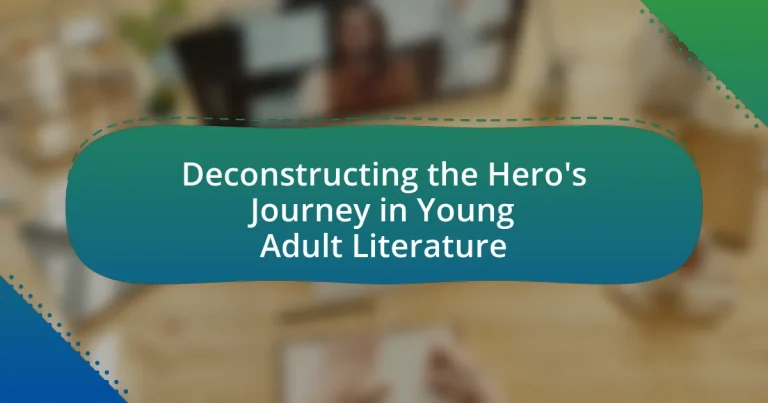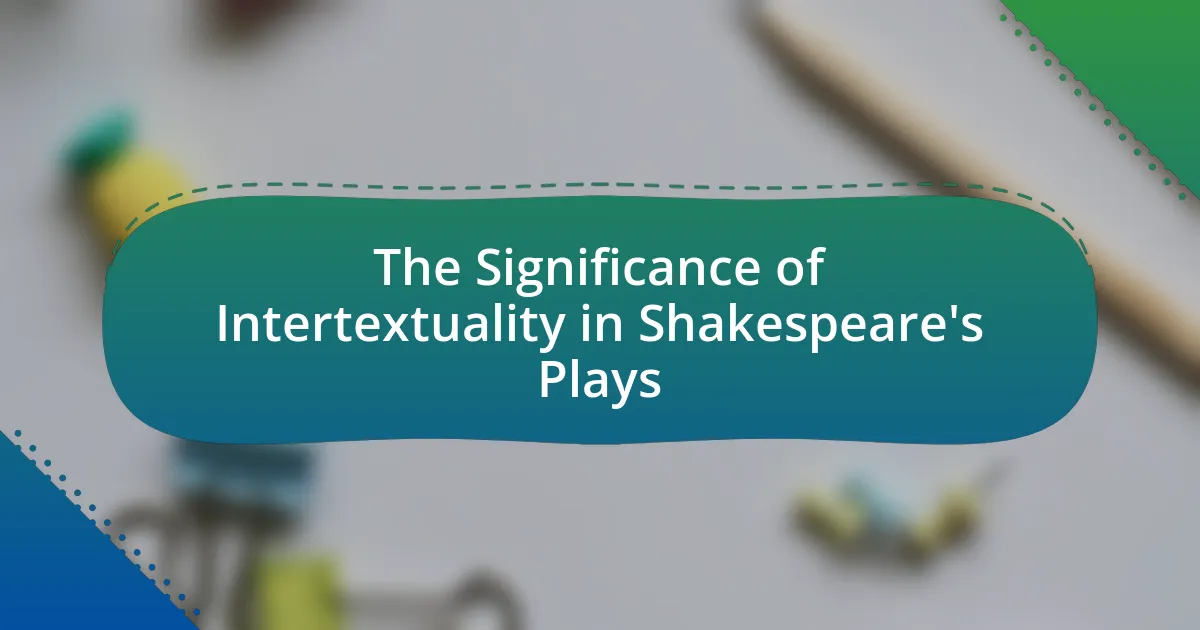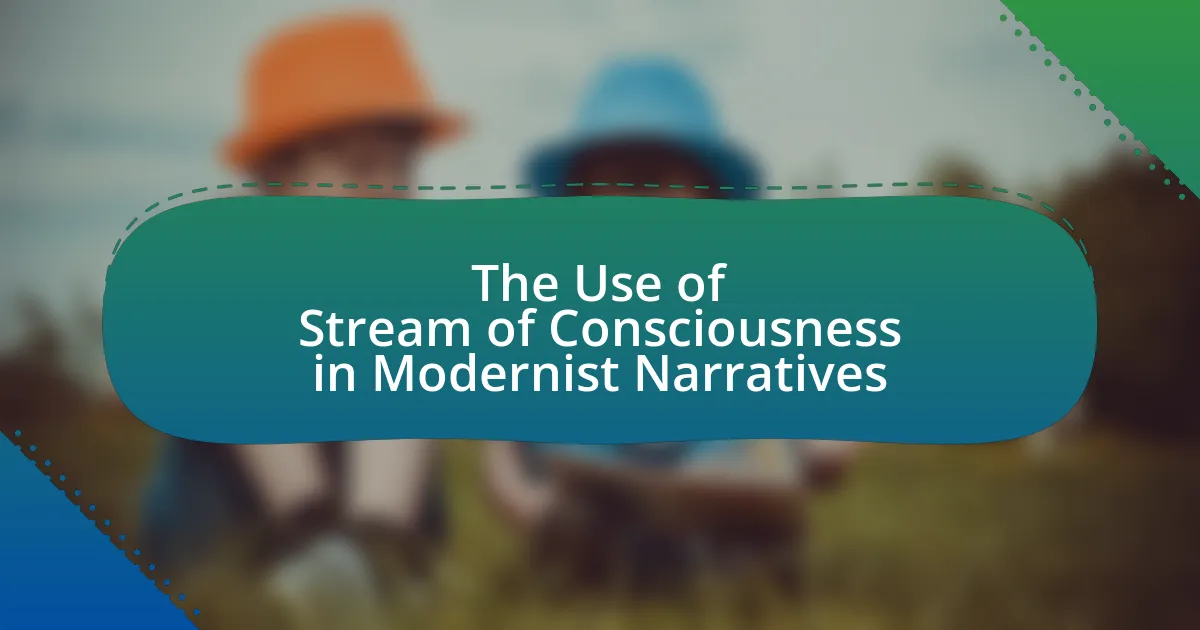The article examines the deconstruction of the Hero’s Journey in Young Adult Literature, a narrative framework that outlines a protagonist’s transformative adventure and personal growth. It highlights key stages of the Hero’s Journey, such as the call to adventure and the return, while emphasizing how contemporary authors challenge traditional archetypes by focusing on internal conflicts and moral complexities. The discussion includes notable examples like “The Hunger Games” and “The Perks of Being a Wallflower,” illustrating how these narratives reflect societal issues and resonate with young readers’ experiences of identity formation. Additionally, the article explores best practices for analyzing these texts, providing insights into character development and thematic elements within the genre.
What is the Hero’s Journey in Young Adult Literature?
The Hero’s Journey in Young Adult Literature is a narrative framework that outlines a protagonist’s adventure, transformation, and return, often reflecting themes of self-discovery and growth. This structure typically includes stages such as the call to adventure, crossing the threshold, facing trials, achieving a revelation, and returning home transformed. Prominent examples include “The Hunger Games” by Suzanne Collins, where Katniss Everdeen evolves from a reluctant participant to a leader, embodying the Hero’s Journey stages. This framework is validated by Joseph Campbell’s work on mythological storytelling, which highlights the universal appeal and psychological resonance of such narratives across cultures and ages.
How is the Hero’s Journey defined in the context of Young Adult Literature?
The Hero’s Journey in the context of Young Adult Literature is defined as a narrative framework that follows a protagonist’s transformative adventure, typically involving stages such as the call to adventure, facing challenges, and achieving personal growth. This structure resonates with young adult readers as it mirrors their own experiences of identity formation and self-discovery during adolescence. For instance, popular novels like “The Hunger Games” and “Harry Potter” exemplify this journey, showcasing characters who confront external conflicts and internal dilemmas, ultimately leading to maturation and empowerment. The prevalence of this archetype in young adult literature underscores its significance in addressing themes of resilience and personal agency.
What are the key stages of the Hero’s Journey?
The key stages of the Hero’s Journey include the following: the Ordinary World, Call to Adventure, Refusal of the Call, Meeting the Mentor, Crossing the Threshold, Tests, Allies, and Enemies, Approach to the Inmost Cave, Ordeal, Reward, The Road Back, Resurrection, and Return with the Elixir. These stages outline a narrative framework that many stories follow, illustrating the hero’s transformation and growth throughout their journey. This structure is widely recognized in literature and film, as evidenced by Joseph Campbell’s work in “The Hero with a Thousand Faces,” where he identifies these stages as universal patterns in storytelling across cultures.
How does the Hero’s Journey differ in Young Adult Literature compared to other genres?
The Hero’s Journey in Young Adult Literature often emphasizes personal identity and emotional growth more than in other genres. In Young Adult narratives, protagonists typically face challenges that are closely tied to their self-discovery and relationships, reflecting the transitional phase of adolescence. For instance, while traditional Hero’s Journey stories may focus on external quests and battles, Young Adult stories like “The Hunger Games” or “Harry Potter” integrate themes of friendship, love, and moral dilemmas, which resonate with young readers navigating their own identities. This focus on internal conflict and character development distinguishes Young Adult Literature from genres that prioritize external action or adventure, such as epic fantasy or classic hero tales.
Why is the Hero’s Journey significant in Young Adult Literature?
The Hero’s Journey is significant in Young Adult Literature because it provides a relatable framework for character development and personal growth. This narrative structure resonates with young readers who are navigating their own transitions from adolescence to adulthood, as it encapsulates themes of self-discovery, challenge, and transformation. For instance, many popular Young Adult novels, such as “The Hunger Games” by Suzanne Collins and “Harry Potter” by J.K. Rowling, utilize this framework to depict protagonists facing trials that lead to their maturation and empowerment. The widespread use of the Hero’s Journey in these stories underscores its effectiveness in engaging young audiences and reflecting their real-life experiences.
What themes are commonly explored through the Hero’s Journey?
The Hero’s Journey commonly explores themes of transformation, self-discovery, and the struggle between good and evil. Transformation is evident as the hero undergoes significant personal growth, often emerging stronger and wiser after facing challenges. Self-discovery is a central theme, as the hero learns about their identity and purpose through trials and tribulations. The struggle between good and evil is frequently depicted, highlighting moral dilemmas and the hero’s quest to overcome darkness. These themes are foundational in narratives across various cultures and are particularly prevalent in young adult literature, where characters often navigate complex emotional landscapes and societal challenges.
How does the Hero’s Journey resonate with young adult readers?
The Hero’s Journey resonates with young adult readers by providing a relatable framework for personal growth and self-discovery. This narrative structure mirrors the transitional phase of adolescence, where young adults often face challenges, seek identity, and strive for independence. The stages of the Hero’s Journey, such as the call to adventure and the return home, reflect the real-life experiences of young adults navigating their own journeys. Research indicates that stories following this archetype can enhance emotional engagement and foster a sense of belonging among readers, as they see their struggles and triumphs mirrored in the characters’ experiences.
How has the Hero’s Journey been deconstructed in contemporary Young Adult Literature?
The Hero’s Journey has been deconstructed in contemporary Young Adult Literature by subverting traditional narrative structures and emphasizing character complexity over archetypal roles. Authors like Patrick Ness in “The Chaos Walking” series and Becky Albertalli in “Simon vs. the Homo Sapiens Agenda” challenge the notion of a singular hero by presenting protagonists who grapple with personal identity, moral ambiguity, and societal expectations. This shift reflects a broader cultural movement towards inclusivity and realism, where characters often face internal conflicts rather than external quests. For instance, in “The Hate U Give” by Angie Thomas, the protagonist’s journey is less about a classic hero’s triumph and more about navigating systemic injustice and personal growth, illustrating the deconstruction of the Hero’s Journey framework.
What are the common critiques of the traditional Hero’s Journey?
Common critiques of the traditional Hero’s Journey include its oversimplification of complex narratives, its reliance on archetypal characters that may not resonate with diverse audiences, and its linear structure that often neglects the nuances of character development. Critics argue that this framework can perpetuate stereotypes and limit the representation of varied experiences, particularly in young adult literature. For instance, scholars like Maureen Murdock in “The Heroine’s Journey” highlight how the Hero’s Journey often excludes female perspectives and experiences, suggesting that alternative narratives may better reflect the complexities of modern storytelling.
How do authors challenge the archetypal hero in their narratives?
Authors challenge the archetypal hero in their narratives by subverting traditional traits associated with heroism, such as bravery, moral clarity, and infallibility. For instance, in young adult literature, characters often display vulnerability, moral ambiguity, and personal flaws, which reflect a more realistic portrayal of human experience. A notable example is in “The Hunger Games” by Suzanne Collins, where Katniss Everdeen embodies both heroic qualities and deep personal conflicts, illustrating the complexities of survival and choice. This approach encourages readers to question the conventional hero’s journey and recognize that heroism can manifest in diverse and imperfect forms.
What alternative narrative structures are emerging in Young Adult Literature?
Alternative narrative structures emerging in Young Adult Literature include non-linear storytelling, multiple perspectives, and epistolary formats. Non-linear storytelling allows authors to present events out of chronological order, creating a more complex narrative that reflects the characters’ emotional journeys. Multiple perspectives enable readers to experience the story through various characters’ viewpoints, enhancing depth and understanding of the plot. The epistolary format, which uses letters, diary entries, or other forms of correspondence, provides an intimate glimpse into characters’ thoughts and feelings, often leading to a more personal connection with the reader. These structures challenge traditional narrative conventions and reflect the complexities of modern adolescent experiences.
How do character development and growth differ in deconstructed Hero’s Journeys?
Character development and growth in deconstructed Hero’s Journeys often emphasize internal struggles and moral ambiguity rather than traditional external victories. In these narratives, characters frequently face complex dilemmas that challenge their values and beliefs, leading to a more nuanced portrayal of growth. For example, in works like “The Perks of Being a Wallflower” by Stephen Chbosky, the protagonist’s journey is less about conquering external foes and more about navigating personal trauma and relationships, illustrating that growth can stem from introspection and emotional resilience rather than heroic feats. This shift reflects a broader trend in young adult literature that prioritizes psychological depth and realism over archetypal heroism.
What role do secondary characters play in the deconstruction of the Hero’s Journey?
Secondary characters play a crucial role in the deconstruction of the Hero’s Journey by challenging the traditional narrative structure and highlighting the complexities of the protagonist’s journey. These characters often serve as foils, providing contrasting perspectives that reveal the limitations of the hero’s singular focus on personal growth and success. For instance, in many young adult novels, secondary characters may embody themes of failure, moral ambiguity, or societal critique, which disrupt the idealized progression of the hero’s journey. This shift encourages readers to question the archetypal hero’s motivations and the implications of their actions, thereby fostering a more nuanced understanding of heroism. By presenting diverse viewpoints and experiences, secondary characters enrich the narrative and emphasize that the journey is not solely about the hero but also about the interconnectedness of all characters within the story.
How do protagonists evolve in non-traditional Hero’s Journeys?
Protagonists in non-traditional Hero’s Journeys evolve through internal conflicts and relational dynamics rather than external quests. This evolution often emphasizes personal growth, self-discovery, and the impact of community over traditional heroic feats. For example, in novels like “The Perks of Being a Wallflower” by Stephen Chbosky, the protagonist Charlie undergoes significant emotional development as he navigates friendships and trauma, illustrating that the journey is more about understanding oneself and one’s place in the world than achieving a grand goal. This shift in focus reflects a broader trend in young adult literature, where character development is prioritized over conventional heroism, showcasing the complexities of adolescence and identity formation.
What are some examples of Young Adult Literature that deconstruct the Hero’s Journey?
Examples of Young Adult Literature that deconstruct the Hero’s Journey include “The Absolutely True Diary of a Part-Time Indian” by Sherman Alexie, which challenges traditional heroism through the lens of a Native American teenager’s struggles. Another example is “The Perks of Being a Wallflower” by Stephen Chbosky, where the protagonist’s journey focuses on personal growth and mental health rather than conventional heroic feats. Additionally, “The Hunger Games” by Suzanne Collins subverts the hero archetype by presenting Katniss Everdeen as a reluctant participant in a brutal system, emphasizing the moral complexities of her choices. These works illustrate how Young Adult Literature can reinterpret the Hero’s Journey by focusing on character development, societal critique, and the nuances of personal experience.
Which novels exemplify a deconstructed Hero’s Journey?
Novels that exemplify a deconstructed Hero’s Journey include “The Absolutely True Diary of a Part-Time Indian” by Sherman Alexie and “The Perks of Being a Wallflower” by Stephen Chbosky. In “The Absolutely True Diary of a Part-Time Indian,” the protagonist, Arnold Spirit Jr., navigates his identity and struggles against societal expectations rather than following a traditional heroic path. Similarly, “The Perks of Being a Wallflower” focuses on Charlie’s internal battles and emotional growth, emphasizing personal development over conventional heroism. Both novels subvert the classic Hero’s Journey by highlighting the complexities of adolescence and the importance of self-discovery.
What unique elements do these novels incorporate into their narratives?
These novels incorporate unique elements such as non-linear storytelling, diverse character perspectives, and subversion of traditional hero archetypes. Non-linear storytelling allows for a fragmented narrative that reflects the complexities of adolescent experiences, as seen in works like “The Perks of Being a Wallflower.” Diverse character perspectives enrich the narrative by showcasing varied cultural backgrounds and identities, exemplified in “The Hate U Give,” which addresses social justice issues through the eyes of a Black teenager. Additionally, the subversion of traditional hero archetypes challenges the notion of a singular hero’s journey, as characters often face moral ambiguity and personal growth rather than clear-cut victories, a theme prevalent in “The Fault in Our Stars.” These elements collectively redefine the hero’s journey, making it more relatable and reflective of contemporary youth experiences.
How do these examples reflect contemporary societal issues?
These examples reflect contemporary societal issues by illustrating themes of identity, mental health, and social justice prevalent in today’s youth culture. Young adult literature often portrays characters grappling with their sense of self in a rapidly changing world, highlighting the struggles of adolescence, such as anxiety and depression, which are increasingly recognized in society. For instance, novels that depict characters facing systemic inequality or discrimination resonate with ongoing discussions about race, gender, and class disparities. This alignment with real-world issues not only engages young readers but also fosters empathy and awareness, making literature a mirror to the complexities of modern life.
What lessons can be learned from the deconstruction of the Hero’s Journey in Young Adult Literature?
The deconstruction of the Hero’s Journey in Young Adult Literature reveals that traditional narratives can be subverted to reflect diverse experiences and identities. This approach emphasizes the importance of character development over archetypal roles, showcasing protagonists who may not fit the conventional hero mold. For instance, novels like “The Hate U Give” by Angie Thomas illustrate how personal and social struggles can redefine heroism, highlighting the significance of agency and moral complexity. Such narratives encourage readers to question societal norms and recognize that heroism can manifest in everyday acts of courage and resilience.
How can readers apply these lessons to their own lives?
Readers can apply the lessons from deconstructing the Hero’s Journey in Young Adult Literature by recognizing the importance of personal growth and resilience in their own lives. By identifying with characters who face challenges and evolve through their experiences, readers can reflect on their own journeys, understanding that obstacles are opportunities for development. Research indicates that narratives featuring character growth can enhance empathy and self-reflection, as seen in studies like “The Role of Narrative in Personal Development” by Green and Brock, which highlights how storytelling influences personal identity and coping strategies. Thus, engaging with these literary lessons can empower readers to embrace their own challenges and foster a mindset geared towards growth and resilience.
What insights do these narratives provide about identity and growth?
These narratives provide insights into the complexities of identity formation and personal growth through the lens of the Hero’s Journey. They illustrate how characters undergo transformative experiences that challenge their beliefs and values, leading to a deeper understanding of themselves. For instance, in young adult literature, protagonists often face external conflicts that mirror their internal struggles, such as in “The Hate U Give” by Angie Thomas, where Starr grapples with her identity in the context of race and social justice. This narrative structure emphasizes that growth often arises from adversity, highlighting the importance of resilience and self-discovery in shaping one’s identity.
What are best practices for analyzing the Hero’s Journey in Young Adult Literature?
Best practices for analyzing the Hero’s Journey in Young Adult Literature include identifying key stages of the journey, such as the call to adventure, crossing the threshold, and the return. This structured approach allows for a clear understanding of character development and thematic elements. Additionally, comparing different texts can reveal how various authors interpret and adapt the Hero’s Journey framework, highlighting cultural and social influences. Engaging with critical essays and scholarly articles on the Hero’s Journey, such as Joseph Campbell’s foundational work, provides a theoretical basis for analysis. Furthermore, utilizing character mapping tools can visually represent the journey, making it easier to track transformations and conflicts throughout the narrative.
How can readers critically engage with texts that utilize or deconstruct the Hero’s Journey?
Readers can critically engage with texts that utilize or deconstruct the Hero’s Journey by analyzing character motivations, narrative structure, and thematic elements. This involves examining how characters conform to or subvert traditional heroic archetypes, which can reveal deeper societal critiques or personal struggles. For instance, in texts like “The Hate U Give” by Angie Thomas, the protagonist’s journey challenges the conventional hero narrative by focusing on social justice rather than individual glory. Additionally, readers should consider the implications of the journey’s stages, such as the call to adventure and the return, to understand how these elements reflect or critique real-world experiences. Engaging with critical essays, such as those found in “The Hero with a Thousand Faces” by Joseph Campbell, can further enhance this analysis by providing a framework for understanding the Hero’s Journey’s cultural significance.
What tools or frameworks can enhance the analysis of these narratives?
Tools and frameworks that can enhance the analysis of narratives in “Deconstructing the Hero’s Journey in Young Adult Literature” include narrative structure analysis, thematic analysis, and character arc frameworks. Narrative structure analysis, such as Freytag’s Pyramid, allows for the examination of plot development and pacing, which is crucial in understanding the hero’s journey. Thematic analysis helps identify recurring motifs and messages within the narratives, providing insight into the underlying themes that resonate with young adult audiences. Character arc frameworks, like the Hero’s Journey model proposed by Joseph Campbell, facilitate the exploration of character development and transformation throughout the story. These tools are validated by their widespread use in literary studies, demonstrating their effectiveness in dissecting complex narratives.




